How to use toBytes method of com.intuit.karate.robot.OpenCvUtils class
Best Karate code snippet using com.intuit.karate.robot.OpenCvUtils.toBytes
Source: RobotBase.java
...370 return screenshot(new Region(this, x, y, width, height));371 }372 public byte[] screenshot(Region region) {373 BufferedImage image = region.capture();374 byte[] bytes = OpenCvUtils.toBytes(image);375 getRuntime().embed(bytes, ResourceType.PNG);376 return bytes;377 }378 @Override379 public Robot move(int x, int y) {380 robot.mouseMove(x, y);381 return this;382 }383 @Override384 public Robot click(int x, int y) {385 return move(x, y).click();386 }387 @Override388 public Element highlight(String locator) {...toBytes
Using AI Code Generation
1def bytes = com.intuit.karate.robot.OpenCvUtils.toBytes(image)2def image = com.intuit.karate.robot.OpenCvUtils.toImage(bytes)3def mat = com.intuit.karate.robot.OpenCvUtils.toMat(bytes)4def bufferedImage = com.intuit.karate.robot.OpenCvUtils.toBufferedImage(mat)5def bufferedImage = com.intuit.karate.robot.OpenCvUtils.toBufferedImage(image)6def bufferedImage = com.intuit.karate.robot.OpenCvUtils.toBufferedImage(bytes)7def image = com.intuit.karate.robot.OpenCvUtils.toImage(mat)8def image = com.intuit.karate.robot.OpenCvUtils.toImage(bytes)9def mat = com.intuit.karate.robot.OpenCvUtils.toMat(image)10def mat = com.intuit.karate.robot.OpenCvUtils.toMat(bufferedImage)11def image = com.intuit.karate.robot.OpenCvUtils.toImage(bufferedImage)12def bufferedImage = com.intuit.karate.robot.OpenCvUtils.toBufferedImage(mat)toBytes
Using AI Code Generation
1def bytes = OpenCvUtils.toBytes(mat)2def mat = OpenCvUtils.toMat(bytes)3def image = OpenCvUtils.toBufferedImage(mat)4def mat = OpenCvUtils.toMat(image)5def image = OpenCvUtils.toBufferedImage(mat)6def image = OpenCvUtils.toBufferedImage(mat)7def mat = OpenCvUtils.toMat(image)8def image = OpenCvUtils.toBufferedImage(mat)9def mat = OpenCvUtils.toMat(image)10def image = OpenCvUtils.toBufferedImage(mat)11def mat = OpenCvUtils.toMat(image)12def image = OpenCvUtils.toBufferedImage(mat)13def mat = OpenCvUtils.toMat(image)14def image = OpenCvUtils.toBufferedImage(mat)15def mat = OpenCvUtils.toMat(image)toBytes
Using AI Code Generation
1def bytes = com.intuit.karate.robot.OpenCvUtils.toBytes(mat)2def image = com.intuit.karate.robot.OpenCvUtils.toImage(bytes)3def mat2 = com.intuit.karate.robot.OpenCvUtils.toMat(image)4def image = com.intuit.karate.robot.OpenCvUtils.toImage(mat)5def mat2 = com.intuit.karate.robot.OpenCvUtils.toMat(image)6def mat = com.intuit.karate.robot.OpenCvUtils.toMat(image)7def image2 = com.intuit.karate.robot.OpenCvUtils.toImage(mat)8def bufferedImage = com.intuit.karate.robot.OpenCvUtils.toBufferedImage(mat)9def mat = com.intuit.karate.robot.OpenCvUtils.toMat(bufferedImage)10def bufferedImage = com.intuit.karate.robot.OpenCvUtils.toBufferedImage(image)11def image = com.intuit.karate.robot.OpenCvUtils.toImage(bufferedImage)12def mat = com.intuit.karate.robot.OpenCvUtils.toMat(bufferedImage)13def bytes = com.intuit.karate.robot.OpenCvUtils.toBytes(bufferedImage)14def bufferedImage = com.intuit.karate.robot.OpenCvUtils.toBufferedImage(bytes)15def mat = com.intuit.karate.robot.OpenCvUtils.toMat(bytes)toBytes
Using AI Code Generation
1def bytes = com.intuit.karate.robot.OpenCvUtils.toBytes(mat)2def mat = com.intuit.karate.robot.OpenCvUtils.toMat(bytes)3def image = com.intuit.karate.robot.OpenCvUtils.toBufferedImage(mat)4def mat = com.intuit.karate.robot.OpenCvUtils.toMat(image)5def image = com.intuit.karate.robot.OpenCvUtils.toBufferedImage(bytes)6def bytes = com.intuit.karate.robot.OpenCvUtils.toBytes(image)7def image = com.intuit.karate.robot.OpenCvUtils.toBufferedImage(bytes)8def image = com.intuit.karate.robot.OpenCvUtils.toBufferedImage(mat)9def mat = com.intuit.karate.robot.OpenCvUtils.toMat(image)10def image = com.intuit.karate.robot.OpenCvUtils.toBufferedImage(bytes)11def bytes = com.intuit.karate.robot.OpenCvUtils.toBytes(imagetoBytes
Using AI Code Generation
1byte[] bytes = OpenCvUtils.toBytes(mat);2Mat mat = OpenCvUtils.toMat(bytes);3BufferedImage image = OpenCvUtils.toBufferedImage(mat);4Mat mat = OpenCvUtils.toMat(image);5BufferedImage image = OpenCvUtils.toBufferedImage(bytes);6byte[] bytes = OpenCvUtils.toBytes(image);7Mat mat = OpenCvUtils.toMat(bytes);8BufferedImage image = OpenCvUtils.toBufferedImage(mat);9Mat mat = OpenCvUtils.toMat(image);10BufferedImage image = OpenCvUtils.toBufferedImage(bytes);11byte[] bytes = OpenCvUtils.toBytes(image);12Mat mat = OpenCvUtils.toMat(bytes);toBytes
Using AI Code Generation
1def img = OpenCvUtils.toBytes (image)2def img = OpenCvUtils.toImage (image)3def img = OpenCvUtils.toMat (image)4def img = OpenCvUtils.toBufferedImage (image)5def img = OpenCvUtils.toBytes (image, format)6def img = OpenCvUtils.toImage (image, format)7def img = OpenCvUtils.toMat (image, format)8def img = OpenCvUtils.toBufferedImage (image, format)9def img = OpenCvUtils.toBytes (image, format, quality)10def img = OpenCvUtils.toImage (image, format, quality)11def img = OpenCvUtils.toMat (image, format, quality)12def img = OpenCvUtils.toBufferedImage (image, format, quality)13def location = OpenCvUtils.findTemplate (image, template, threshold)14def location = OpenCvUtils.findTemplate (image, template, threshold, method)toBytes
Using AI Code Generation
1import com.intuit.karate.robot.OpenCvUtils2def image = OpenCvUtils.toBytes(imageBuffer)3import com.intuit.karate.robot.OpenCvUtils4def image = OpenCvUtils.toImage(imageBytes)5import com.intuit.karate.robot.OpenCvUtils6def image = OpenCvUtils.toMat(imageBuffer)7import com.intuit.karate.robot.OpenCvUtils8def image = OpenCvUtils.toBufferedImage(imageMat)9import com.intuit.karate.robot.OpenCvUtils10def image = OpenCvUtils.toBufferedImage(imageMat)11import com.intuit.karate.robot.OpenCvUtils12def image = OpenCvUtils.toGray(imageBuffer)13import com.intuit.karate.robot.OpenCvUtils14def image = OpenCvUtils.toGray(imageMat)15import com.intuit.karate.robot.OpenCvUtils16def image = OpenCvUtils.toBufferedImage(imageMat)17import com.intuit.karate.robot.OpenCvUtils18def image = OpenCvUtils.toGray(imageMat)toBytes
Using AI Code Generation
1byte[] bytes = OpenCvUtils.toBytes(mat);2BufferedImage bufferedImage = ImageIO.read(new ByteArrayInputStream(bytes));3BufferedImage bufferedImage = OpenCvUtils.toBufferedImage(mat);4BufferedImage bufferedImage = OpenCvUtils.toBufferedImage(bytes);5byte[] bytes = OpenCvUtils.toBytes(mat);6BufferedImage bufferedImage = OpenCvUtils.toBufferedImage(bytes);7Mat mat = OpenCvUtils.toMat(bufferedImage);8Mat mat = OpenCvUtils.toMat(bytes);9byte[] bytes = OpenCvUtils.toBytes(bufferedImage);10Mat mat = OpenCvUtils.toMat(bytes);11byte[] bytes = OpenCvUtils.toBytes(bufferedImage);12byte[] bytes = OpenCvUtils.toBytes(mat);13Mat mat = OpenCvUtils.toMat(bufferedImage);14byte[] bytes = OpenCvUtils.toBytes(mat);15BufferedImage bufferedImage = OpenCvUtils.toBufferedImage(mat);16byte[] bytes = OpenCvUtils.toBytes(bufferedImage);17byte[] bytes = OpenCvUtils.toBytes(mat);18BufferedImage bufferedImage = OpenCvUtils.toBufferedImage(bytes);19byte[] bytes = OpenCvUtils.toBytes(mat);20BufferedImage bufferedImage = OpenCvUtils.toBufferedImage(bytes);21BufferedImage bufferedImage = OpenCvUtils.toBufferedImage(mat);22Mat mat = OpenCvUtils.toMat(bufferedImage);23byte[] bytes = OpenCvUtils.toBytes(bufferedImage);24Mat mat = OpenCvUtils.toMat(bytes);Blogs
Check out the latest blogs from LambdaTest on this topic:
I routinely come across test strategy documents when working with customers. They are lengthy—100 pages or more—and packed with monotonous text that is routinely reused from one project to another. Yawn once more— the test halt and resume circumstances, the defect management procedure, entrance and exit criteria, unnecessary generic risks, and in fact, one often-used model replicates the requirements of textbook testing, from stress to systems integration.
When it comes to UI components, there are two versatile methods that we can use to build it for your website: either we can use prebuilt components from a well-known library or framework, or we can develop our UI components from scratch.
Building a website is all about keeping the user experience in mind. Ultimately, it’s about providing visitors with a mind-blowing experience so they’ll keep coming back. One way to ensure visitors have a great time on your site is to add some eye-catching text or image animations.
Automation Testing Tutorials
Learn to execute automation testing from scratch with LambdaTest Learning Hub. Right from setting up the prerequisites to run your first automation test, to following best practices and diving deeper into advanced test scenarios. LambdaTest Learning Hubs compile a list of step-by-step guides to help you be proficient with different test automation frameworks i.e. Selenium, Cypress, TestNG etc.
LambdaTest Learning Hubs:
- JUnit Tutorial
- TestNG Tutorial
- Webdriver Tutorial
- WebDriverIO Tutorial
- Protractor Tutorial
- Selenium 4 Tutorial
- Jenkins Tutorial
- NUnit Tutorial
- Jest Tutorial
- Playwright Tutorial
- Cypress Tutorial
- PyTest Tutorial
YouTube
You could also refer to video tutorials over LambdaTest YouTube channel to get step by step demonstration from industry experts.
Most used method in OpenCvUtils
Try LambdaTest Now !!
Get 100 minutes of automation test minutes FREE!!



